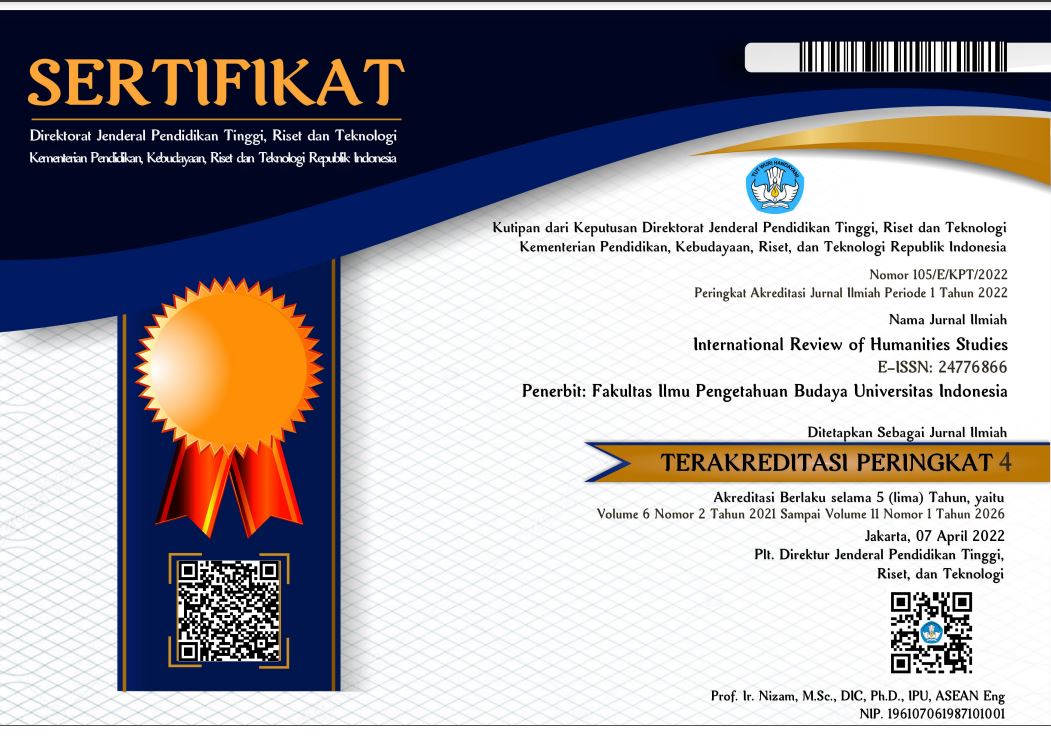International Review of Humanities Studies

Abstract
Although there have been more Hollywood movies having their stories centered on female characters, their representation in Hollywood cinema is still problematic as most of these female characters do not become subjects in their own stories. They often internalize the notion of women as the Other. According to Beauvoir (2010), since women are deemed to be the Other, they become inessential part of the society. In the movie Blue Jasmine (2013), Jasmine has no power to design and lead her future as she subjugates herself to men. Then when she tries to free herself from this situation, she experiences oppression that comes from a male higher-up. Using textual analysis to analyze this character, this paper found that what she experiences represents women‟s everyday struggles in the society which resembles Beauvoir‟s concept of immanence and transcendence. Jasmine initially is stuck in immanence, when she depends on men, letting them have power over her. When she wants to take control over her own life, getting her independence, through education, she can achieve transcendence. However, this does not happen, and she falls back into the immanence instead because her environment makes it impossible for a woman to transcend. Moreover, this failure leads to her tragic ending which conveys a message that in the society women are bound to immanence.
References
Barghini, Tiziana. (March 8, 2012). Educated women quit work as spouses earn more. Retrieved August 9, 2018 from https://www.reuters.com/article/us-economy- women/educated-women-quit-work-as-spouses-earn-more-idUSBRE8270AC20120308
Boulé, J., & Tidd, U. (2015). Existentialism and contemporary cinema. New York: Berghahn Books.
Crowell, Steven. (March 9th, 2015). Existentialism. Retrieved from https://plato.stanford.edu/entries/existentialism/ on December 10th, 2017.
De Beauvoir, Simone. (2010). The second sex. (C. Borde & S. Malovany-Checallier, Trans.). New York, NY: Random House, Inc. (Original work published 1949).
Green, Karen. (2002) The other as another other. Retrieved from http://www.jstor.org/stable/3810906.
Hancock, Elizabeth. (March, 2012). Film and the second sex: situations and characters in Popular Hollywood cinema. Oregon: University of Oregon. Kitroeff, Natalie. (May 28, 2017). Why are so many women dropping out of the workforce?. Retrieved August 9, 2018 from https://www.reuters.com/article/us-economy- women/educated-women-quit-work-as-spouses-earn-more-idUSBRE8270AC20120308
McCabe, Janet. (2004). Feminist film studies: writing the woman into cinema. New York: Columbia University Press
Morgan, Kathryn. (1986). Romantic love, altruism, and self respect: an analysis of Simone de Beauvoir. Retrieved from ttp://www.jstor.org/stable/3810066.
Oria, Beatriz. (2007). Genre and Ideology in Woody Allen‟s Another Woman (1988). Zaragoza: University of Zaragoza.
Shepherd, Angela. (2015). De Beauvoir and the second sex: a marxist interpretation. UK: University of Hull.
Tidd, Ursula. (2004). Simone de Beauvoir. London: Routledge.
Recommended Citation
Veneralda, Livina and Mintarsih, Adriana Rahajeng
(2019)
"JASMINE’S FAIL ATTEMPT TO ACHIEVE ‘TRANSCENDENCE’ AS A FORM OF HER INTERNALIZATION AS ‘THE OTHER’ IN BLUE JASMINE (2013),"
International Review of Humanities Studies: Vol. 4:
No.
1, Article 11.
Available at:
https://scholarhub.ui.ac.id/irhs/vol4/iss1/11
Included in
Architecture Commons, Art and Design Commons, Feminist, Gender, and Sexuality Studies Commons, Social and Behavioral Sciences Commons


